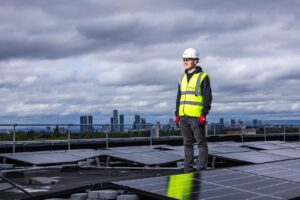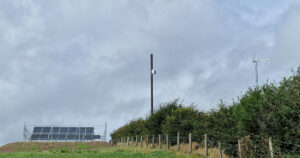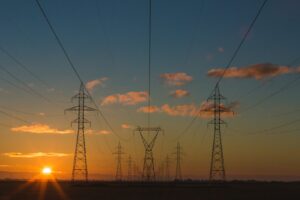A home that will keep you warm and cool the planet
If climate change makes you want to want to stay in bed all day and forget the world outside then I have some bad news.
About 28% of global CO₂ emissions can be traced to the energy generated to light, cool and heat buildings, while a fifth of the UK’s emissions come from heating and powering homes. So a good chunk of your carbon footprint can be laid down before you’ve even left the house.
And that’s just the emissions that governments tend to count. Much of housing’s greenhouse gases come at other stages in a home’s life, including construction and demolition.
These are called ’embodied emissions’ and can make up as much as 90% of the whole-life emissions of some buildings.
This includes everything from mining the materials for the cement to chopping down the trees for the floorboards to transporting everything to the building site to digging the foundations; and then later from knocking the building down to disposing of its constituent parts.
There are likely to be an extra 2 billion people on Earth by 2050, with most being born throughout Asia and Africa. Developing countries will need hundreds of millions of additional homes over the coming decades, while global emission will need to fall by 60% to keep average warming below 2°C.
First, let’s ditch concrete
Concrete is a wonder material, but like most of the innovations behind modern life’s conveniences, it’s carbon-intensive.
Fired bricks need temperatures higher than 1,000°C to cause chemical changes that give the material strength, and it’s as high as 1,450°C for cement. Just producing cement is thought to account for between 5-10% of global greenhouse gas emissions.
Since most new homes will be built in the developing world, experts agree that a greener concrete substitute will have to be affordable, attractive and made from locally sourced ingredients. But perhaps ‘green’ isn’t the right word.
Alastair Marsh, a research fellow in civil engineering at the University of Leeds, and Venkatarama Reddy, a professor of civil engineering at the Indian Institute of Science, believe that soil could be the perfect component for geopolymers – a naturally strong and durable alternative to cement.
This electron microscope image shows the transformation of montmorillonite clay, left, a common component of soil, into a geopolymer, right.
Soil is taken from beneath the valuable surface layer and mixed with chemicals similar to those found in household cleaning products to dissolve the clay minerals into their constituent atoms.
A playdough-like mix is formed that can be shaped in brick moulds. During firing at 80-100°C, the dissolved atoms rearrange to form a geopolymer, stabilising the remaining soil.
Soil-based geopolymers can be fired at lower temperatures and their ingredients don’t need to be shipped long distances. Depending on the conditions, these bricks could have half the carbon emissions of concrete, and a quarter of the amount produced by conventional fired bricks.
Back to basics – Earth-based housing has been the norm in many parts of the world for thousands of years, so there is a rich cultural history behind this idea in most places.
Then let’s talk about heating
Bricks and mortar are just the start.
Heating and energy use is the long-term source of carbon emissions in housing – it accounts for 18% of the UK’s total emissions. Even homes made with sustainable materials will leak heat and guzzle electricity if poorly designed.
Stephen Berry, a research fellow at the University of South Australia, argues that our ancestors knew how to design homes that could regulate temperature without energy and regardless of the climate.
Some 2,300 years before the first electric refrigerator, Persians engineered cold storage units that made ice available year-round even through scorching desert summers.
By implementing design features that capture cool air and keep rooms aerated, Iranian architects were leading the world in zero-carbon home design – more than a thousand years before people started thinking about the emissions from their home energy use.
Decarbonisation starts at home
If you’re living in a damp and drafty home that was built long before you were born, you might envy anyone living in a zero-energy new build. While you pay much higher heating bills, a lot of that precious warmth could be lost through poorly insulated walls and windows.
A recent study found that leaky homes are a common problem throughout Europe – particularly the UK, where on average 3°C is lost from homes every five hours during winter.
But if a house is still reliant on burning natural gas to heat a water boiler, the source of carbon emissions remains.
There are more than 23 million homes with gas supply for heating and cooking in the UK – an energy burden that amounts to more than double the country’s annual electricity consumption and produces about 60 million tonnes of CO₂ emissions each year.
One way to decarbonise gas heating is to swap the fuel for something zero-carbon, like hydrogen gas. Another is to switch gas-fired boilers and ovens with electrical appliances.
Electricity can be converted directly to heat with 100% efficiency using cheap resistive elements – the same parts that are present in fan heaters and oil-filled radiators.
Heat pumps use electricity to extract the input heat from a nearby river or stream, from the ground or from the air itself.
Recycling rainwater to help run electric heating is one (particularly creative) way of decarbonising energy use in homes, but it doesn’t count for much if the electricity came from burning fossil fuels.
Energy cooperatives have formed between neighbours, where homes can generate, store, and trade energy with each other.
Germany reached 32% renewable electricity in 2015 with a target of 40% to 45% by 2025 and has some 850 energy cooperatives. Almost half of its installed capacity is owned by households, communities and farmers.
Denying the state a monopoly on renewable energy could win supporters that are usually sceptical of government efforts to limit climate change.
Smarter energy grid – Fewer big power plants would be needed if electricity generation came from multiple sources, disrupting centralised monopolies. Smart distribution systems could regulate this supply efficiently by, for example, providing electricity generated from solar panels on an empty house to busy schools and offices nearby.
Pay when you use, not how much – Energy utilities currently set consumers’ tariffs according to the volume of energy they use. This system means it’s not in the interest of the energy producer to help people reduce their demand or become more energy efficient. A smarter, decentralised system could instead charge customers according to when they use energy.
Overhaul housing entirely
Regardless of collective ambition on climate change, housing will have to change drastically in many places in the years ahead to help people resist the world outside.
In the UK, 1.8 million people currently live in areas that are at significant risk of flooding – and their flood risk is likely to increase as the climate warms. According to Hannah Cloke, professor of hydrology at the University of Reading, we may need to consider:
Radical practices from parts of the world that flood more frequently … such as houses that are designed to float when floods come, rising on stilts as the water rises … There are less dramatic adaptations that can be made. Internally reinforced, mechanically sealable flood doors … Waterproof concrete and stone-slab floors.
Electrical sockets can be raised and non-return valves can be fitted to toilets to stop sewage filling homes when it floods.
Storm Dennis wreaked havoc in Wales and northern England in February 2020. Making homes resilient to flooding is an urgent priority as the climate warms.
Rather than retreat into bunkers fortified with solar panels and flood doors, Matthew Paterson, professor of international politics at the University of Manchester, highlights that the roots of modern housing policy elicit a collective response.
This article is republished from The Conversation under a Creative Commons license. Read the original article here.
Photo Credit – Pixabay















